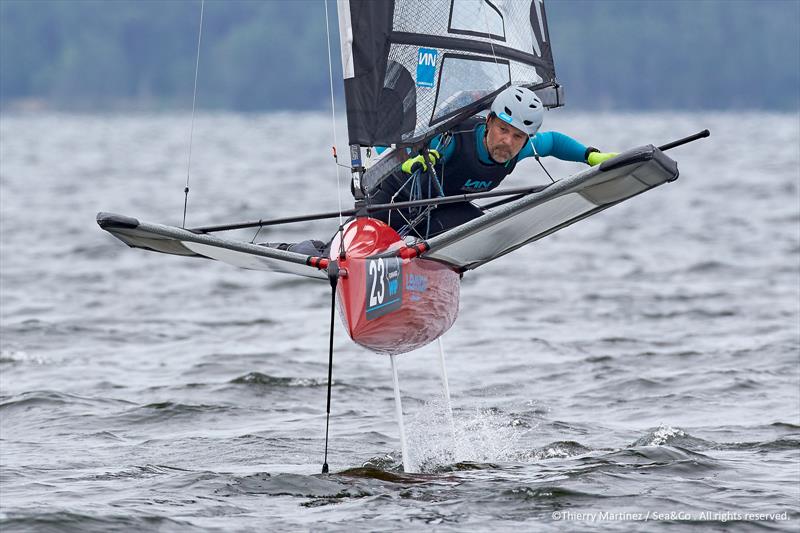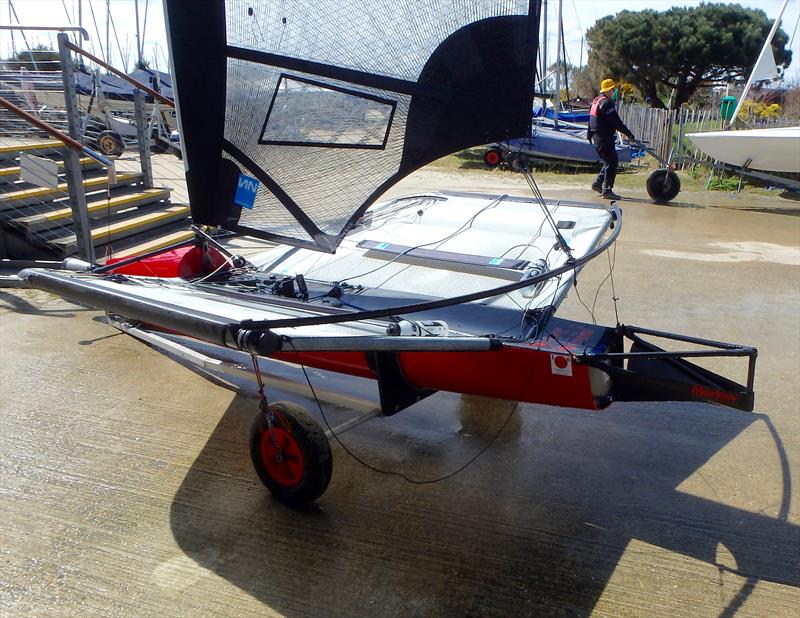Moth Europeans win at 50

Mark Jardine: You're clearly going fast right now - you won by a 10 point margin over Chris Rashley who was also second at the International Moth World Championship in Japan. What do you attribute your speed to at the moment?
Mike Lennon: I haven't done that much competitive sailing this year - I've done two open meetings in the UK and that's it. I've been fast in the past; winning the Nationals at Hayling in 2014 and I came second to Chris in the Europeans a few years ago. I've always been quick upwind but I've struggled a bit downwind generally and that's always been my Achilles heel. So downwind is something I've been concentrating on since the Worlds at Hayling in 2014.
About a month ago I switched to a stiffer mast and that really has been transformational to the downwind speed. I then switched out of the A1m type sails I had been working on into the A3m we developed last year, this is a more luff curve oriented sail and works well with the stiffer mast as with enough downhaul and vang the mast will bend until the luff curve is removed, making a full sail flat. This is the sail which both Paul Goodison and Chris Rashley used to take 1st and 2nd at the recent Worlds.
We also now use very powerful controls on the rigs. Last year I used a 12:1 downhaul but now I'm using an 18:1 downhaul and I think I need that with the stiffer mast to get the sail flat. With the fuller sail you do need to start pulling the cunningham on much earlier, in 7-8 knots of windspeed.
I was also using small foils in far lighter wind conditions than I would have considered before, which really worked well on the first day.

Mark: The championship was held on a lake wasn't it?
Mike: Yes, there's a lake which runs about a kilometre from the ocean. It's quite a big lake, big enough to get a course across its width, relatively shifty with the thermal winds running across the lake being the strongest wind direction.
Mark: I noticed last year at the Moth UK Nationals at Stokes Bay that Chris Rashley was sailing the boat much harder than anybody else downwind. Did you find with your new setup you were sailing the boat harder downwind?
Mike: It's hard to say because Stokes Bay is Chris's home water and he's developed a particular technique that gives him an advantage there. People like Dylan Fletcher say they can live with him in Portland Harbour but can't get near him in Stokes Bay. It's an aggressive technique and he sails it quite hard, but in Maubuisson it was more about staying in the pressure and soaking off sometimes just to stay in the pressure. It was a very different kind of racing to Stokes Bay in a South Westerly.
Mark: We've just had the A Class Catamaran Worlds and this class has seen the deck-sweeper mainsails introduced last year and dominating the top results. I know you've been developing a concept deck-sweeper sail for the International Moth - how are your experiments going with that?
Mike: The Moth fleet has been trying to lower the rig for several years and the end-plate effect is something, but it's not the main thing. The main focus in the Moth is getting the centre of effort down, lowering the rig height and gaining more righting moment. We are restricted by the fact that we need to get under the boom and you need triangulation for the vang, a certain distance from the gooseneck to the kicking strap, and if that distance gets too small then you can't generate the power in the vang. Some people are already using 52:1 on their vang systems on an 8 sq. metre sail which is crazy.
Earlier this year I tried a mainsheet traveller track on the back of the boat and sheeted effectively from the transom, the mainsheet itself effectively became the vang and you play the traveller, then you only need a 4:1 system and you can get more load in the leech with that than a 52:1 vang system, so it was worth trying, but there are a lot of downsides to it in terms of sailing the boat.
The A Class has a big, stable platform and you can let go of the tiller in the tack and do all kinds of stuff that you can't get away with in a Moth. I had to have twin tiller extensions so that they stayed in front of the mainsheet and the mainsheet track length is limited by the class rules - you can't have anything wider that the boat - so the track has to stop where the racks stop so that's the working range you've got.
In theory it would work and you could deck-sweep the mainsail, gaining nearly a foot in rig height and getting an end-plate effect on the deck, but we found no discernible difference in boat speed and it was far trickier to sail.

Mark: Would a wishbone rig, similar to that used in the new WASZP, provide a solution?
Mike: People have talked about it and of course A-Mac's done that on the WASZP, but you still need to derive huge amounts of leech tension. I just don't think you'd be able to get the tension that is required. The main thing that overrides everything is getting the right shape - all the other gains such as lowering the rig or getting an end-plate effect are tiny in comparison to having the right sail and mast combination.
The key is being able to flatten your sail upwind and being able to get it full enough downwind - that overrides all other considerations. If you can create a sail that's really versatile, lower the centre of effort and get an end-plate effect that would be the ultimate goal.
Mark: So that's your nirvana in sail design?
Mike: Yes, but getting the extras at the expense of sail shape is pointless.
Mark: So what's the plan for the rest of your season?
Mike: I've got the Nationals at the end of August but that's the next big thing. I don't travel as much as I used to now I'm an old man and have children. I've been sailing since I was 12 and I'm 50 years old now so I don't have the urge to compete in every regatta under the sun like I might have done 20 years ago. I enjoy the ones I do but I pick them carefully!
Mark: Well you're still pretty successful at 50 years young!
Mike: I try my best!
Mark: Congratulations on winning the Moth Europeans against such a hot fleet and many thanks for your time.
Mike: Thank you.
